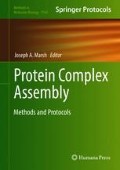Abstract
In this chapter, we describe how NMR chemical shift titrations can be used to study the interaction between two proteins with emphasis on mapping the interface of the complex and determining the binding affinity from a quantitative analysis of the experimental data. In particular, we discuss the appearance of NMR spectra in different chemical exchange regimes (fast, intermediate, and slow) and how these regimes affect NMR data analysis.
Access this chapter
Tax calculation will be finalised at checkout
Purchases are for personal use only
References
Zuiderweg ERP (2002) Mapping protein-protein interactions in solution by NMR spectroscopy. Biochemistry 41:1–7
Vaynberg J, Qin J (2006) Weak protein-protein interactions as probed by NMR spectroscopy. Trends Biotechnol 24:22–27
Takeuchi K, Wagner G (2006) NMR studies of protein interactions. Curr Opin Struct Biol 16:109–117
Fielding L (2007) NMR methods for the determination of protein-ligand dissociation constants. Prog Nucl Magn Reson Spec 51:219–242
O’Connell MR, Gamsjaeger R, Mackay JP (2009) The structural analysis of protein-protein interactions by NMR spectroscopy. Proteomics 9:5224–5232
Vinogradova O, Qin J (2012) NMR as a unique tool in assessment and complex determination of weak protein-protein interactions. Top Curr Chem 326:35–45
Stamenova SD, French ME, He Y et al (2007) Ubiquitin binds to and regulates a subset of SH3 domains. Mol Cell 25:273–284
Ortega Roldan JL, Casares S, Jensen MR et al (2013) Distinct ubiquitin binding modes exhibited by SH3 domains: molecular determinants and functional implications. PloS One 8:e73018
Williamson MP (2013) Using chemical shift perturbation to characterise ligand binding. Prog Nucl Magn Reson Spec 73:1–16
Jensen MR, Ortega-Roldan JL, Salmon L et al (2011) Characterizing weak protein-protein complexes by NMR residual dipolar couplings. Eur Biophys J 40:1371–1381
Waudby CA, Ramos A, Cabrita LD et al (2016) Two-dimensional NMR Lineshape analysis. Sci Rep 6:24826
Palmer AG, Kroenke CD, Loria JP (2001) Nuclear magnetic resonance methods for quantifying microsecond-to-millisecond motions in biological macromolecules. Methods Enzymol 339:204–238
Sugase K, Dyson HJ, Wright PE (2007) Mechanism of coupled folding and binding of an intrinsically disordered protein. Nature 447:1021–1025
Hansen DF, Vallurupalli P, Kay LE (2008) Using relaxation dispersion NMR spectroscopy to determine structures of excited, invisible protein states. J Biomol NMR 41:113–120
Salmon L, Ortega Roldan JL, Lescop E et al (2011) Structure, dynamics, and kinetics of weak protein-protein complexes from NMR spin relaxation measurements of titrated solutions. Angew Chem 50:3755–3759
Schneider R, Maurin D, Communie G et al (2015) Visualizing the molecular recognition trajectory of an intrinsically disordered protein using multinuclear relaxation dispersion NMR. J Am Chem Soc 137:1220–1229
Kragelj J, Palencia A, Nanao MH et al (2015) Structure and dynamics of the MKK7-JNK signaling complex. Proc Natl Acad Sci 112:3409–3414
Delaglio F, Grzesiek S, Vuister GW et al (1995) NMRPipe: a multidimensional spectral processing system based on UNIX pipes. J Biomol NMR 6:277–293
Goddard TD, Kneller DG. SPARKY 3, University of California, San Francisco
Ortega Roldan JL, Romero Romero ML, Ora A et al (2007) The high resolution NMR structure of the third SH3 domain of CD2AP. J Biomol NMR 39:331–336
Ortega Roldan JL, Jensen MR, Brutscher B et al (2009) Accurate characterization of weak macromolecular interactions by titration of NMR residual dipolar couplings: application to the CD2AP SH3-C:ubiquitin complex. Nucleic Acids Res 37:e70
Bodenhausen G, Ruben DJ (1980) Natural abundance nitrogen-15 NMR by enhanced heteronuclear spectroscopy. Chem Phys Lett 69:185–189
Pervushin K, Riek R, Wider G et al (1997) Attenuated T2 relaxation by mutual cancellation of dipole-dipole coupling and chemical shift anisotropy indicates an avenue to NMR structures of very large biological macromolecules in solution. Proc Natl Acad Sci 94:12366–12371
Ikura M, Kay LE, Bax A (1990) A novel approach for sequential assignment of 1H, 13C, and 15 N spectra of proteins: heteronuclear triple-resonance three-dimensional NMR spectroscopy. Application to calmodulin. Biochemistry 29:4659–4667
Kay LE, Ikura M, Tschudin R et al (1969) (1990) three-dimensional triple-resonance NMR spectroscopy of isotopically enriched proteins. J Magn Reson 89:496–514
Jung YS, Zweckstetter M (2004) Mars – robust automatic backbone assignment of proteins. J Biomol NMR 30:11–23
Dominguez C, Boelens R, Bonvin AMJJ (2003) HADDOCK: a protein-protein docking approach based on biochemical or biophysical information. J Am Chem Soc 125:1731–1737
Schumann FH, Riepl H, Maurer T et al (2007) Combined chemical shift changes and amino acid specific chemical shift mapping of protein-protein interactions. J Biomol NMR 39:275–289
Clore GM, Tang C, Iwahara J (2007) Elucidating transient macromolecular interactions using paramagnetic relaxation enhancement. Curr Opin Struct Biol 17:603–616
Tolman JR, Flanagan JM, Kennedy MA et al (1995) Nuclear magnetic dipole interactions in field-oriented proteins: information for structure determination in solution. Proc Natl Acad Sci 92:9279–9283
Tjandra N, Bax A (1997) Direct measurement of distances and angles in biomolecules by NMR in a dilute liquid crystalline medium. Science 278:1111–1114
Blackledge M (2005) Recent progress in the study of biomolecular structure and dynamics in solution from residual dipolar couplings. Prog Nucl Magn Reson Spec 46:23–61
Marley J, Lu M, Bracken C (2001) A method for efficient isotopic labeling of recombinant proteins. J Biomol NMR 20:71–75
Mulder FAA, Schipper D, Bott R et al (1999) Altered flexibility in the substrate-binding site of related native and engineered high-alkaline Bacillus subtilisins 1. J Mol Biol 292:111–123
Author information
Authors and Affiliations
Corresponding author
Editor information
Editors and Affiliations
Rights and permissions
Copyright information
© 2018 Springer Science+Business Media, LLC, part of Springer Nature
About this protocol
Cite this protocol
Ortega-Roldan, J.L., Blackledge, M., Jensen, M.R. (2018). Characterizing Protein-Protein Interactions Using Solution NMR Spectroscopy. In: Marsh, J. (eds) Protein Complex Assembly. Methods in Molecular Biology, vol 1764. Humana Press, New York, NY. https://doi.org/10.1007/978-1-4939-7759-8_5
Download citation
DOI: https://doi.org/10.1007/978-1-4939-7759-8_5
Published:
Publisher Name: Humana Press, New York, NY
Print ISBN: 978-1-4939-7758-1
Online ISBN: 978-1-4939-7759-8
eBook Packages: Springer Protocols

